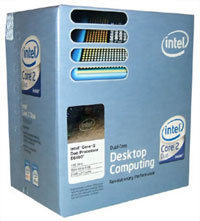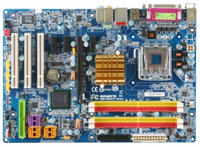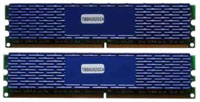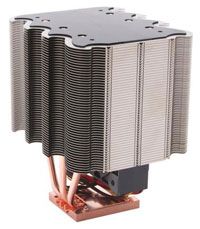Midrange Overclocking Configuration
The final category we have to talk about involves everyone's favorite topic: overclocking. We have shown in
recent articles that certain CPUs can outperform processors that cost six times as much once you add in overclocking. A lot of people also like the thought of getting "something for nothing," so we will conclude this Buyer's Guide with some upgrades intended to help you get the most out of your overclocking endeavors.
| Intel Mid-Range Overclocking System |
| Hardware |
Component |
Price |
Rebates |
| Processor |
Intel Core 2 Duo E6400 (2.13GHz 2MB Shared) - Retail |
$223 |
|
| Heatsink |
Tuniq Tower 120 |
$55 |
|
| Motherboard |
Gigabyte GA-965P-DS3 (P965 775) |
$138 |
|
| Memory |
Super Talent 2x1GB DDR2-800 (T800UX2GC4) |
$268 |
|
| Video Card |
eVGA GeForce 7600GT 256MB (256-P2-N550 -T2) |
$131 |
|
| Hard Drive |
Seagate 320GB SATA 3.0Gbps 7200RPM 16MB (Barracuda 7200.10) |
$90 |
|
| Optical Drive |
LG Black 18X DVD+R (GSAH22N-BK) |
$36 |
|
| Case |
Antec Solution SLK3000-B |
$76 |
|
| Power Supply |
OCZ GameXStream 700W (OCZ700GXSSLI) |
137 |
|
| Display |
Acer AL2016W 20" 8ms (1680x1050) |
$233 |
|
| Speakers |
Logitech X-530 5.1 70W Speakers |
$74 |
|
| Keyboard and Mouse |
Microsoft Comfort Curve 2000 B2L-00047 |
$28 |
|
| Operating System |
Windows XP MCE 2005 (with Vista coupon) |
$115 |
|
| Bottom Line |
|
$1604 |
$1604 |
 |
So far in this guide, AMD platforms have been a reasonable alternative to Intel's Core 2 Duo platform. They may not be faster in many cases, but at the lower end of the dual core spectrum the price/performance is nearly identical when comparing Athlon X2 and Core 2 Duo. Once you add in overclocking, however, there's no way that we would currently recommend AMD over Intel. There are still some AMD chips that can achieve impressive overclocks - one of our editors for instance is running an Athlon X2 4000+ (2.0GHz 1MB cache stock) at 3.08 GHz - but with many Core 2 Duo overclocks reaching 3.5 GHz and higher AMD is not currently able to match that level of performance, short of resorting to phase change cooling.
 |
Besides the processor, there are several critical components that can help increase overclocking potential as well as providing improved stability. First of course is the motherboard, which almost goes without saying. A great chipset alone can't provide for excellent overclocking, and at the same time the world's best BIOS programmers can't overcome chipset limitations. When you get a great chipset with an excellent motherboard design and the proper BIOS, however, the results can be extremely impressive. There are motherboards that overclock better than Gigabyte's GA-965P-DS3, but with the latest BIOS update and the price of under $150 it is very difficult to beat the DS3. The ASUS P5B-E we mentioned previously is a close second; the DS3 costs a bit less and overclocks a bit further, while the ASUS has a few more features.
 |
Next on the upgrade requirements for overclocking has to be memory. You can get some very respectable overclocks using just about any DDR2-800 memory, but if you want to push into the 500MHz bus speed overclocks and beyond, you'll need memory that can function at DDR2-1000 and higher. As this is a midrange guide, we didn't want to go to extreme on the memory side of things, but the Super Talent memory we mentioned previously can easily reach DDR2-1000 at 2.2V and we feel that's sufficient given our other components. Using a 1:1 memory:bus ratio (which is typically optimal for overclocking), DDR2-1000 means you can run a 500MHz bus. You may have noticed that we didn't select an E6300 processor, and the reason is that we don't want the RAM and bus speed to be the limiting factors. An E6300 with a 500MHz bus would be running at 3.5 GHz, and while that's certainly an impressive overclock we prefer the 8X multiplier of the E6400. It is doubtful that you will be able to run most E6400 chips at 4.0GHz, but hitting somewhere around 3.6-3.7 GHz isn't uncommon.
 |
The last two items that are important when looking at maximum overclocking are CPU/system cooling and the power supply. The stock Intel heatsink performs quite well, but it's still not able to match the cooling prowess of the better aftermarket solutions. As we showed in our recent article, the
Tuniq Tower 120 was able to dramatically lower processor temperatures, and it also improved overclocking headroom by about 200MHz. It manages to do this without generating a lot of noise, and for a cost of about $60 it provides a far better long-term overclocking solution than the stock heatsink. In order to overclock most CPUs beyond a certain point, it is necessary to increase the processor voltage. This in turn increases the heat generated by the CPU, so adequate cooling becomes even more critical. Large aftermarket heatsinks like the Tuniq Tower 120 may be a bit more difficult to install, but they are still highly recommended for anyone looking to push their CPU to the limit.
 |
Increasing processor and memory voltages naturally puts a larger strain on the power supply. Several of the other editors have burned through quite a few power supplies during overclocking attempts, especially at the more extreme end of the equation. When we looked at upgrading the power supply to something that would be suitable for intense overclocking, we found that most of the 500W to 600W power supplies really didn't cost much less than the 700W PSU that we selected. The Fortron Source FX700-GLN is essentially the same power supply as the OCZ GameXStream 700W, and it's priced about the same. However, the Fortron Source comes with a two-year warranty while OCZ has a three-year warranty, so the choice is pretty clear.
We stuck with a pretty average GPU on our overclocking system - faster than the base 7600GS, but a 7600GT is by no means a graphics powerhouse these days. NVIDIA cards typically overclock better than AMD offerings, but the 7600GT is already factory overclocked and probably can't get much faster. If you want to get a high-performance GPU with more overclocking headroom, the GeForce 8800 GTS cards appear to be the best bet right now. They're already fast at stock speeds, but overclocking has helped quite a few people reach near 8800 GTX performance levels at 2/3 the cost. As always, your mileage may vary, and we would tend to be a bit more cautious with overclocking GPUs as opposed to CPUs.
So what's the bottom line when it comes to overclocking? For about $300 more, you can most likely get a Core 2 Duo E6400 to run twice as fast as the stock E6300. Individual results will of course vary, as no two processors are identical, but we are reasonably confident that knowledgeable overclockers will be able to hit 3.6 GHz or more with this particular configuration. If you wanted to stick with the basic Intel configuration we listed and simply overclock that, you could probably hit 2.8 GHz before running into the limitations of the memory and motherboard, but you would also end up with a processor that was running somewhat warm. Before you go out and jump on the configuration we just listed, however, keep in mind that the Core 2 Duo E4300 will be available shortly with a lower price, and with the lower base front side bus speed and a 9X multiplier it should be able to reach 9x400 (3.6 GHz) simply by adding a better aftermarket heatsink.
Conclusion
We've covered no less than five potential system builds in this Midrange Buyer's Guide, and still we haven't covered every possibility. However, with the information we've provided, you should now have enough information to get started building your own ideal midrange computer. As always, comments and questions are welcome. There are always new products launching, and some of those will surpass the components we have selected here, but for now these component choices offer some of the best bang for the buck on the market.















43 Comments
View All Comments
Mermaidman - Friday, August 31, 2007 - link
Come on guys, my AMD Barton is getting long in the tooth and UT2007 is around the corner! :)Sunrise089 - Sunday, January 21, 2007 - link
Jarred:Thanks again for another stand-out article. Despite what other may chime in (and the usual complaints by the PSU nazis that want us to spend more on a commodity component then a CPU or motherboard) this new system makes MUCH more sense than having many AMD and Intel options for what had basically become guides based on personel preference rather than rational performance. There is no reason to choose AMD for certain applications, overclocking one of them, just as there is no reason to choose Intel in others (say a sub $100 CPU). Just coming out and saying that through a build list is a wonderfull step in the right direction. I think it's crazy that users still insist on an all AMD or all Intel series of builds, when noone insists on all ATI or all nVidia.
In short, it makes much more sense to break up the builds based on the very different usage requirements - especially due to some users not OC'ing and therefore having totally different CPU, motherboard, and HSF needs than an arbitrary division of the guides based on CPU brand.
Keep up the good work!
SaII - Sunday, January 21, 2007 - link
This article has all the PSU configs wrong, get at least a GOOD branded PSU for an 8800GTSand that 700W PSU for the overclocking config is over the top over-kill.
Give the overclocking one the OCZ 600W PSU and 700W OCZ for the gaming rig.
JarredWalton - Sunday, January 21, 2007 - link
I'd say if you want a really good PSU for overclocking or gaming, plan on spending around $120 or so, which will get you the 700W OCZ listed or a variety of other high-quality 500-600W PSUs. I will take the PSU complaints under consideration next midrange guide, but seriously for gaming (WITHOUT overclocking), the only thing that really needs more than a good quality 400W PSU is going to be SLI/CrossFire setups, and even then 400W is usually enough.sirdowny - Sunday, January 21, 2007 - link
Just out of curiosity, has anyone heard about any problems with the Tuniq Tower 120 and it's massive weight? Seems like it would be a good cooler assuming it were used in a case that sat horizontally (like an HTPC), but am I the only one who has reservations about letting that brick dangle from my motherboard?SaII - Sunday, January 21, 2007 - link
I have it, it works wonders, and the only ones that have problems is user error.Zepper - Saturday, January 20, 2007 - link
Things author should know:1- Rosewill is one of Newegg's in-house packagers. Some folks won't or can't buy from Newegg/ChiefValue which is (I say is because they are the same company) the only place you can get the Rosewill brand except for perhaps some Mom & Pop shops who may buy stock from them.
2- Who actually makes that PSU so the folks referred to above can get one if they want (not that they would when such a unit as the Enhance ENP-5150GH exists with aPFC and full-range AC auto sensing is available for nearly the same money). In most cases Rosewill packages ATNG/Coolmax PSUs - if this IS a Deer then it should NEVER have been recommended - its output ratings are identical to the Coolmax 600 but the physical layout is not.
In any case, recommending Rosewill comes with risks - not the least of which is becoming a laughing stock in the community (again, if this is really a Deer then that might be well deserved). They do package some decent products like the R6A and R560x case lines - but unless you know the history of the OEM of the item, it's a pig-in-a-poke. Caveat emptor!
..bh.
Le Québécois - Saturday, January 20, 2007 - link
Are they really rebranding Deer PSU now? Do you know if any other brand use Deer as base PSU?This is the worst know brand I can think of. When I worked as a technician in a computer store, every time someone brought us a computer with a broken Deer PSU inside, almost every components of the computer had blown at the same time the PSU did. Using Deer PSU in a computer is almost like putting a time bomb in it.
mostlyprudent - Saturday, January 20, 2007 - link
Anyone know whether one of the basic configurations (AMD or Intel) from this article would perform better for a system running primarily Photoshop? I had configured two systems for a friend which are very similar to those in this article and was going to let them decide based on price and the general performance difference between the X2 3800 and E6300. It will basically be a web/email/document PC with the exception of a prosumer Photoshop user.JarredWalton - Sunday, January 21, 2007 - link
Core 2 Duo will typically be a bit faster in Photoshop, although in my opinion having a lot of RAM is more important for most professional PS work. Now if we can just get a 64-bit PS version so people can effectively use 4+ GB of memory.... :)